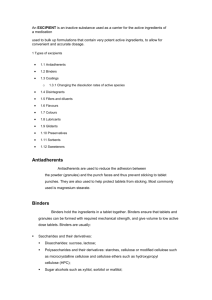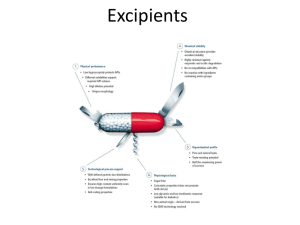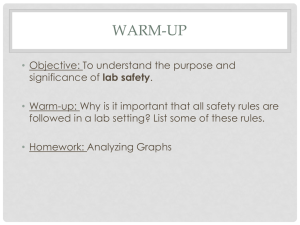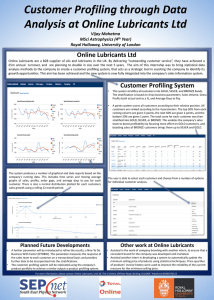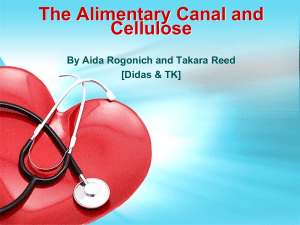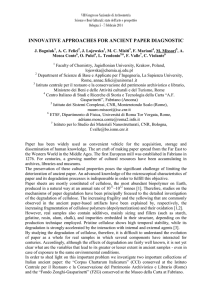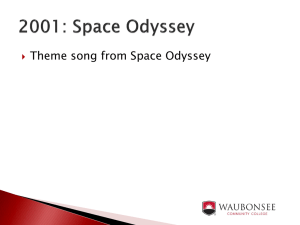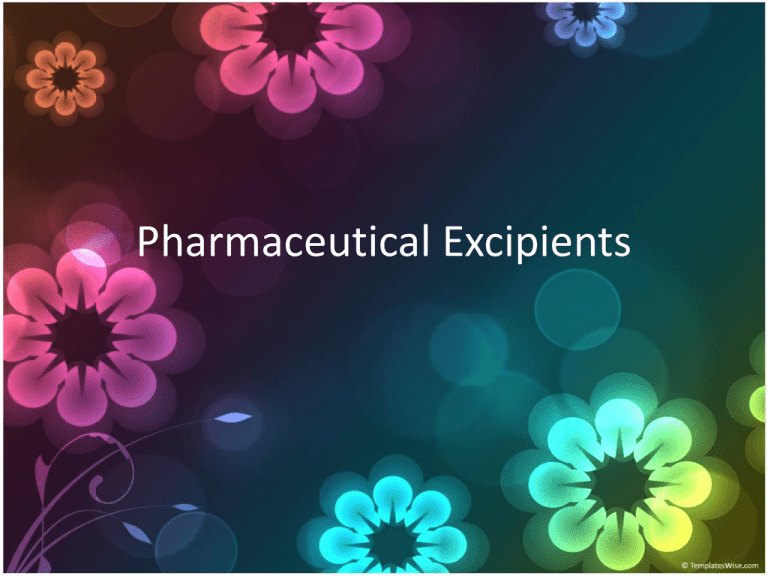
Pharmaceutical Excipients
Excipients
• An excipient is
generally a pharmacologically
inactive substance used
as a carrier for the
active ingredients
of a medication.
Why we use Excipients?
• In many cases, an "active" substance (such as acetylsalicylic
acid ) may not be easily administered and absorbed by the
human body; in such cases the substance in question may be
dissolved into or mixed with an excipient.
• Excipients are also sometimes used to bulk up formulations
that contain very potent active ingredients, to allow for
convenient and accurate dosage.
• In addition to their use in the single-dosage quantity,
excipients can be used in the manufacturing process to aid in
the handling of the active substance concerned.
Excipients
•
•
•
•
•
•
•
•
•
•
•
•
Antiadherents
Binders
Coatings
Disintegrants
Fillers
Flavours
Colours
Lubricants
Glidants
Sorbents
Preservatives
Sweeteners
Antiadherents
• Antiadherents are used to reduce the
adhesion between the powder (granules) and
the punch faces and thus prevent sticking to
tablet punches.
• They are also used to help protect tablets
from sticking.
• Most commonly used is magnesium stearate.
Binders
• Binders hold the ingredients in a tablet together.
Binders ensure that tablets and granules can be
formed with required mechanical strength, and give
volume to low active dose tablets.
Binders are usually:
• Saccharides and their derivatives:
– Disaccharides: sucrose, lactose
– Polysaccharides and their derivatives: starches,
cellulose or modified cellulose such as microcrystalline
cellulose and cellulose ethers such as hydroxypropyl
cellulose (HPC);
– Sugar alcohols such as xylitol, sorbitol or maltitol;
• Protein: gelatin
• Synthetic polymers: polyvinylpyrrolidone (PVP),
polyethylene glycol (PEG)...
Classification of Binders
Binders are classified according
to their application:
• Solution binders : gelatin, cellulose,
cellulose derivatives, starch, sucrose and
polyethylene glycol.
• Dry binders :cellulose, methyl cellulose,
polyvinylpyrrolidone and polyethylene glycol.
Coatings
• Tablet coatings protect tablet ingredients from
deterioration by moisture in the air and make
large or unpleasant-tasting tablets easier to
swallow.
• For most coated tablets, a cellulose ether
hydroxypropyl methylcellulose (HPMC) film
coating is used which is free of sugar and
potential allergens.
• Occasionally, other coating materials are used,
for example synthetic polymers, shellac, corn
protein zein or other polysaccharides.
• Capsules are coated with gelatin.
Disintegrants
• Disintegrants expand and dissolve when wet causing
the tablet to break apart in the digestive tract,
releasing the active ingredients for absorption.
• They ensure that when the tablet is in contact with
water, it rapidly breaks down into smaller fragments,
facilitating dissolution.
• Examples of disintegrants include:
• Crosslinked polymers: crosslinked polyvinylpyrrolidone
(crospovidone), crosslinked sodium carboxymethyl
cellulose (croscarmellose sodium).
• The modified starch sodium starch glycolate.
Fillers
Fillers fill out the size of a tablet or capsule, making it
practical to produce and convenient for the consumer
to use.
A good filler must be
• inert, compatible
• non-hygroscopic,
• relatively cheap,
• compactible,
• tasteless or pleasant tasting.
Examples of fillers : lactose, sucrose, glucose, mannitol,
sorbitol, calcium carbonate, and magnesium stearate.
Flavours
Flavours can be used to mask unpleasant tasting active ingredients
and improve the acceptance that the patient will complete a
course of medication. Flavourings may be natural (e.g. fruit extract)
or artificial.
For example, to improve:
• a bitter product - mint, cherry or anise may be used
• a salty product - peach, apricot or liquorice may be used
• a sour product - raspberry or liquorice may be used
• an excessively sweet product - vanilla may be used
Colours
Colours are added to improve the appearance of a formulation.
Colour consistency is important as it allows easy identification of a
medication.
Lubricants
Lubricants prevent ingredients from clumping together and
from sticking to the tablet punches or capsule filling
machine.
• Common minerals like talc or silica, and fats, e.g.
vegetable stearin, magnesium stearate or stearic acid
are used as lubricants.
Two major types of lubricants:
• 1. Hydrophilic
Generally poor lubricants, no glidant or anti-adherent
properties.
• 2. Hydrophobic
Generally good lubricants , anti- adherent and glidant
properties.
Examples include magnesium stearate.
Glidants
Glidantsare used to promote powder flow by reducing
interparticle friction and cohesion. These are used in
combination with lubricants as they have no ability to
reduce die wall friction.
Examples include fumed silica, talc, and magnesium
carbonate.
Sorbents
• Sorbents are used for tablet/capsule moisture-proofing by
limited fluid sorbing (taking up of a liquid or a gas either by
adsorption or by absorption) in a dry state.
• Preservatives
• Some typical preservatives used in pharmaceutical
formulations are
• Antioxidants like vitamin A, vitamin E, vitamin C, retinyl
palmitate, and selenium
• The amino acids cysteine and methionine
• Citric acid and sodium citrate
• Synthetic preservatives like the parabens: methyl paraben
and propyl paraben.
Sweeteners
• Sweeteners are added to make the ingredients more
palatable, especially in chewable tablets such as antacid or
liquids like cough syrup. Sugar can be used to mask
unpleasant tastes or smells.
THANK YOU

